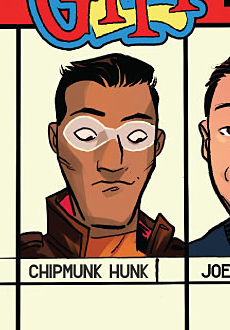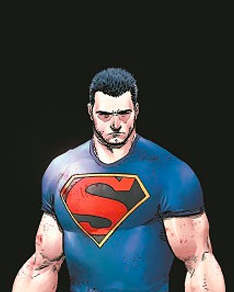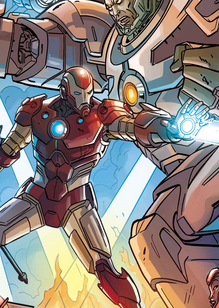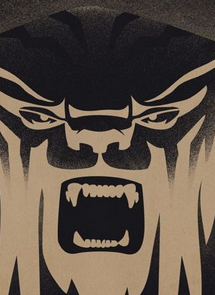Deadshirt Is Reading… is a weekly feature in which Deadshirt’s staff, contributing writers, and friends-of-the-site offer their thoughts on Big Two cape titles, creator-owned books, webcomics and more. For more of our thoughts on this week’s new comics, take a look at Wednesday’s Deadshirt Comics Shopping List.
David Uzumeri is reading…
Written by Greg Pak and Aaron Kuder
Art by Aaron Kuder
Colored by Tomeu Morey and Hi-Fi
Lettered by Steve Wands
DC Comics
“Simple pleasures. I could get used to ‘em.”
That quote takes place a page after Superman, when asked by a kid “you really are Superman, aren’t you?” thinks “hell, yeah” while driving down an interstate riding a motorcycle, sporting a crewcut and a tight-fitting T-shirt with his logo on it that he bought from a gift shop. On the surface, this sounds like a bastardization of the character and his concept, but au contraire: Superman has never been closer to his roots.
Especially since the advent of the New 52, Superman has been a personality chameleon from run to run. The Superman Grant Morrison was writing in Action Comics was nothing like the one George Perez or Scott Lobdell was writing in Superman; Geoff Johns’s take on the character was practically a complete throwback to his pre-Flashpoint self, with the sole constant characterization coming from Pak himself—inspired by Morrison’s take on Clark’s farmboy roots, and threaded between his runs on this title and Batman/Superman.
Now, Pak and Kuder bring the character even closer to his core. Deprived of most of his powers and costume, shorn of his secret identity, Superman is now just a strong dude on a kick-ass motorcycle riding around, battling bullies, and fighting for truth, justice, and the American way.
When I say the American way, I don’t mean the cynical reading that phrase often brings up in modern discourse: he’s a dude who fights for people who can’t fight themselves, even though he’s severely diminished. Aaron Kuder’s co-plotting, along with his art duty, comes across clearly in the final product, especially in just how amicable Clark is. He’s a literal Social Justice Warrior, against all odds: friend of the helpless, fighter of oppressors, bloody-knuckled with a determined face.
As different from the norm as the storyline might be, what comes across through both the writing and the art is Clark’s incredible warmth. Kuder communicates it, without the benefit of dialogue or captions, in every scene of him happily hanging out with children or chilling out with neighbors from his old block. More than ever before, the man is there in Superman, and Pak and Kuder work together to transform a portrait of a demigod looking over us all into a guy with more means than most of us doing what he can to bring justice to the less fortunate. It’s kind of beautiful. I love it.
Joe Stando is reading…
Written by James Robinson
Art by Marcio Takara
Colored by Esther Sanz
Lettered by Travis Lanham
Marvel
“No, this time it’s Stark Tech business. Actually, it’s not even that. Honestly… this is all about family.”
Thus far in the overall Secret Wars event, there are two kinds of tie-ins. The first kind is those that tell stories like a classical What If? issue or series, with the focus primarily on the story itself (“what if Spider-Man and Mary-Jane didn’t split up?”) and less concerned with the unique status quo of Battleworld. The second kind leans heavily into the lore of Battleworld, emphasizing elements like Thors, domains, and the general strangeness of the world. Both approaches have yielded great stories, and Armor Wars is a solid example of the latter being used to great effect.
Technopolis is an Iron Man-themed domain in which everyone wears armor at all times, but even its Baron, Tony Stark, knows something is off. But before he can investigate further, he has to deal with the likes of criminal kingpin Wilson Fisk and his brother/rival, Arno Stark. It’s an interesting setup that bears very little resemblance to the original Armor Wars story, choosing instead to focus on how this domain works and how it interacts with the rest of the world.
Look, I’m a big fan of Iron Man specifically, and armored heroes in general. Scott Snyder’s making a mecha Batman? Sign me up. The Ant-Man movie’s villain is in a robot suit with shoulder cannons? Hell yeah. So I was already sold when I saw that we got an armored Spider-Man and Thor and Arno as major players in this book. But beyond that, Robinson and Takara have put together a world that’s both interesting on its own and as a puzzle piece. The designs aren’t just clever and varied; they reveal a lot about the characters who wear them, and those who manufactured them. Armored Thor isn’t just a fun, silly gimmick; it’s a use of James Rhodes that’s both true to the character himself and fits well into the Secret Wars context. Everything in here catches the eye of wacky, fun-loving Joe, but it also provides depth and fodder for discussion for “wants to keep up with David Uzumeri” Joe.
I’ve been almost universally pleased with the Secret Wars tie-ins thus far. Every week there’s a new crop of established top-tier creators or bold new names using the relative carte blanche that the event affords to show off their skills. Armor Wars is definitely among my favorites, and a worthy pick for any of your pull lists.
Jason Urbanciz is reading…
Written by Tom King
Art by Barnaby Bagenda
Colored by Romulo Fajardo Jr.
Lettered by Pat Brosseau
DC Comics
“We will not hurt you. We are your friends.”
The quote above is repeated several times throughout this comic. First by a group of soldiers, raiding a house of worship seeking the insurgent terrorist group, Omega Men. They chant it like a mantra as they murder worshippers who offer them little resistance. Once they find the Omega Men, the soldiers have the words mockingly spat back at them as they’re killed.
Omega Men is a heavy, violent book, but it comes at its violence from an interesting angle. The Citadel has taken control of the Vegan system, with only the Omegas still left to fight back against them. In the sneak preview DC put out last month, they appeared to publicly execute White Lantern Kyle Rayner (who was there to negotiate a truce) to illustrate their resolve. It’s rare to see a comic in which the “heroes” of the book are out and out terrorists, but it is a refreshing take. The only team member to get a lot of characterization in this first issue is their leader, Primus, a pacifist who is confronting for the first time the fact that, to serve his ideals, he must kill. He’s suitably troubled by that notion, and it allows the reader to better empathize with him.
The art on the book is lovely. Barnaby Bagenda uses a fairly rigid nine-panel structure that gives the comic an air of formality. His art has a painterly aspect to it, though that could be an effect of Romulo Fajardo’s sumptuous colors. He uses cold blues in the backgrounds to play off the deep purples and orange hues of the various alien races’ skintones, all of which work together to give the art a lot of depth.
Omega Men #1 is an interesting start to the series. Though it feels a little light on story at first, it definitely deepens when reread. I would definitely suggest tracking down the preview story (free on Comixology) before reading this, as it adds a lot of context to the story. While it’s easy to see parallels in this comic to America’s recent forays into nation-building in the Middle East, it doesn’t come off as ham-handed or glib. Omega Men is tackling serious, real-world issues in a smart way that may actually help people to empathize next time we drop bombs on someone and are shocked to learn they don’t like us.
Kayleigh Hearn is reading…
 The Unbeatable Squirrel Girl #6
The Unbeatable Squirrel Girl #6
Written by Ryan North
Art by Erica Henderson and Eloise Narrington
Colored by Rico Renzi
Lettered by VC’s Clayton Cowles
Marvel
“Who would’ve thought that the only thing my fists of justice couldn’t punch…was his heart?”
Squirrel Girl is a very silly comic. Of course, no one reads The Unbeatable Squirrel Girl expecting a grim, Herzog-ian exploration of the battle between man and nature, but this is an extremely goofy comic book. I say that with affection; Ryan North and Erica Henderson have crafted an issue that’s lively, colorful, bizarre, and very charming.
This issue is essentially two stories in one. We first find Squirrel Girl and her roommate Nancy defending a local bank from a genetically engineered, financially strapped Hippo the Hippo, and they’re suddenly joined by Chipmunk Hunk and Koi Boi. Adding not one, but two new heroes who can talk to animals (and also have adorable rhyming names) at first feels like spreading a joke awfully thin, but it’s ultimately saved by the sheer cuteness of Henderson’s art. Later, Doreen hangs out at the Bronx Zoo, where she encounters a new superhero named…Girl Squirrel? Reader, I cannot explain to you why this tiny talking squirrel literally named “Girl Squirrel” made me laugh so hard, but it did.
Squirrel Girl is a comic that revels in its own ridiculousness, and it also mines humor from some of the strangest corners of Marvel’s history. A rampaging hippopotamus man is funny enough; a rampaging hippopotamus man in a “ß Skrull” t-shirt suddenly becomes brilliant. Unbeatable Squirrel Girl #6 is a welcome reprieve from the sometimes exhausting intensity of Secret Wars and its tie-ins, and I’m pleased Doreen Green has her own little corner of the Marvel Universe to scamper around in.
Thanks for reading about what we’re reading! We’ll be back next week with a slew of suggestions from across the comics spectrum. In the meantime, what are you reading? Tell us in the comments section, on Twitter or on our Facebook Page!




